Adventurers who have their sights set on the Galápagos Islands have one more option for experiencing the destination this year and beyond. Thanks to a partnership with Quito, Ecuador-based Metropolitan Touring, Norway’s Hurtigruten Expeditions is now plying the warm waters of the Pacific Ocean archipelago, offering several itinerary options.
Luxury Travel Advisor joined the expedition cruise line as it made its first foray into the Galápagos, sailing a portion of the nine-day “Galápagos Islands Expedition – In Darwin’s Footsteps” itinerary aboard the recently renovated Santa Cruz II. Inclusive of two nights in Quito before the sailing, the route visits San Cristóbal, Santa Fe, South Plaza Island, Santa Cruz, Española Island and North Seymour Island, as well as Baltra, the embarkation and disembarkation point.
Like any expedition to the Galápagos, the sailing is wildlife-centric, so expect lots of time up close with animals in their natural habitat. Throughout the voyage, you will be able to spot sea lions, fur seals, several species of iguana (including marine iguanas, which you can find swimming in shallow areas), and a bunch of seabirds like albatross, the famed blue-footed boobies, frigate birds and more. Of the “Big 15,” this sailing only misses out on the flightless cormorant and the Galápagos penguin (which we were bummed about!).
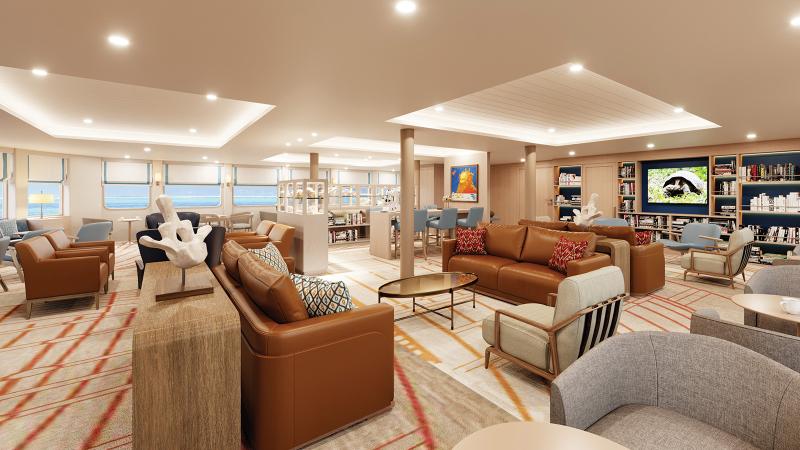
One animal encounter highlight, of course, is the giant tortoise, which guests will get to see on San Cristóbal and Santa Cruz Island. At the former (on Day 4), you will visit the Cerro Colorado Tortoise Reserve. Despite “giant” being in their name, it’s still shocking how large some get, as they never stop growing. That means the larger the tortoise, the older he or she is. And they can get pretty old, too—some estimate they live well over 100 years old.
Later that day, guests will take a RIB (rigid inflatable boat, which are referred to as pangas onboard) to Punta Pitt on the eastern side of the island. Here, you will be able to spot all three species of boobies (blue-footed, red-footed and Nazca) on your hike. Snorkeling is another option at this stop and it’s definitely a must, as you have the opportunity to spot sea lions (mostly the young ones) swimming and playing with each other in the water.
Another chance to get up close with the giant tortoises comes on Day 6. Guests will head ashore at Puerto Ayora, Santa Cruz—the largest town in the archipelago—en-route to a visit to the Charles Darwin Research Station, where over 200 scientists and volunteers are working to conserve the wildlife of the Galápagos. At the breeding enclosures you can see baby tortoises in incubators (you will also be able to spot finches, as made famous by Darwin). The group then heads for the highlands for lunch, where you will dine at Rancho El Manzanillo, a family-run farm that many giant tortoises call home. Following a tasty bite to eat, you will head out with your guide across the property to enjoy the tortoises up close.
Nice Touch: As the ground can get muddy, we liked that guests were provided with tall rainboots to don as we traversed the property. Fortunately, too, we visited in the rainy season and the skies opened up during our visit. But a little rain didn’t deter our group from making the most of the experience.
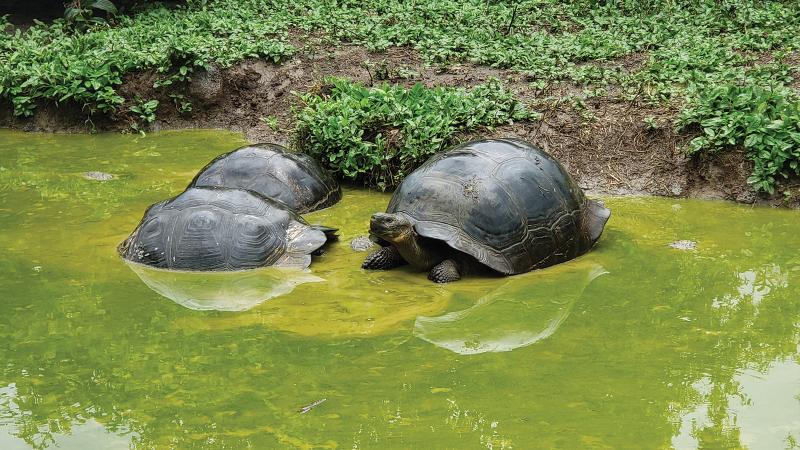
On Day 7, at Punta Suarez, Española Island, the morning hike offered a view that made the entire trip worth it. Besides a variety of birds, like the waved albatross (“in season” from April to December), blue-footed boobies, Nazca boobies and swallow-tailed gulls, plenty of lizard species and even a few lounging sea lions, at this stop guests will also have a chance to witness the Galápagos’ famous “blowhole.” Thanks to a crevice in the rocky terrain right near the shoreline, when a wave from the tide comes in, it will shoot water into the air upwards of 75 feet. While you can’t get too close (for safety reasons), the view from the cliffside about one hundred yards away was just as nice and we didn’t mind taking the time to rest, drink some water (bring lots on your hikes) and enjoy the scenery.
Day 8’s morning activity was a panga ride along the shores of Eden Islet, Santa Cruz. Since we prefer more active excursions, we weren’t sure what we’d think of the boat ride to check out the wildlife that lives along the shallow waters and right on shore — but it was surprisingly fun. Mostly, it provided guests the chance to see sting rays and juvenile reef sharks swimming in protected inlets. Later that day, following a hike on North Seymour Island — home to plenty bird colonies — is another panga ride that gets you up close to the Galápagos fur seals that hang out on the rocky shoreline (which would be impossible to reach by foot).
Tip: While you must stay six feet away from all animals, most of them have no fear of/ aren’t concerned by humans, so getting even that close usually isn’t a challenge. A few times, in particular with the younger sea lions and fur seals, they came up to us and even gave us a sniff (our guide said it was OK as long as we stood still). The up-close animal encounters never got old.
Life on Board
Many of the days aboard Santa Cruz II will follow a similar pattern: Buffet breakfast in the morning, usually around 7 a.m., followed by a group shore excursion, whether that be a hike or a visit to one of the reserves / research stations. It’s back on board before 11 a.m., where guests can sit in on a “science talk” led by an expedition leader, which is followed by lunch. One such science talk on our sailing included showing various native life (such as a sea urchin and pieces of coral) under a microscope before passing them around to get a hands-on look. During another, guides displayed plaster molds of bones from the wildlife, explaining how they have evolved for life in the Galápagos. Following lunch it was time for the afternoon activities (there were a selection of choices, some of which you need to sign up for the night before). Activities included snorkeling, kayaking, stand-up paddle boarding, tours in a glass-bottomed boat and beach hikes. These usually begin around 3 or 4 p.m. and last around until 6 p.m.
As we were told before and throughout our voyage, the sun in the Galápagos is no joke—the islands lie just south of the equator. While it can seem like a lot, getting on and off the boat so often for the myriad shore and water excursions, the idea is to give you the most time to explore the destination when the sun isn’t its strongest and get you back on the boat for lunch when it’s hottest.
While breakfast was buffet service each morning, lunch and dinner were both à la carte, with several options of appetizers, entrées and desserts for each. Tip: There was always at least one vegetarian or vegan offering for all meals. In fact, dining on board was a real highlight. Everything we ate was very tasty and we didn’t mind having a three-course meal for lunch and dinner every day—since we were so active, we needed all that fuel.
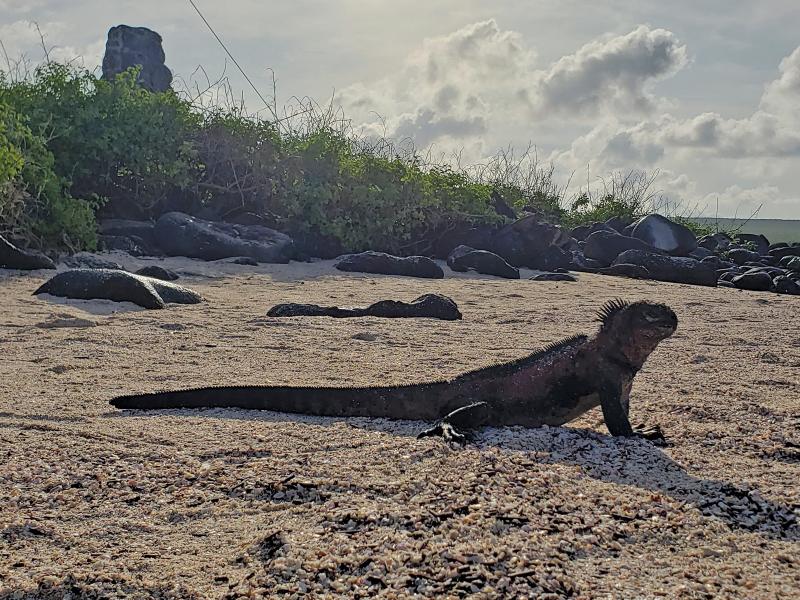
Tip: At breakfast, the wait staff provides the lunch menu and takes your order (don’t worry, you can change it should you want; but the idea is to create less food waste). At lunch, they will do the same with the dinner menu. An added benefit: The food is being prepped before the meals, so plates are dropped as soon as you’re seated. It was nice not having to wait even those extra few minutes as we were usually pretty hungry from our morning and afternoon excursions.
About the vessel: MS Santa Cruz II was custom-built for small-ship exploration and has just 50 cabins and suites, accommodating a maximum of 90 passengers. Leading up to the 2022 season, it underwent a $10-plus million upgrade, which covered everything from the public areas to cabins and suites. The 20-year-old vessel is effectively operating as a brand-new ship with a modern Nordic design. Besides the 323-square-foot Darwin Suites, the ship also has dedicated family (194 square feet) and single (129 square feet) cabins to suit a variety of travelers. The standard Explorer Cabin totals 161 square feet and was plenty of space for the amount of time we spent in the room.
All cabins have also been upgraded with new mattresses and beddings; they also have large windows with electronic controls and a compact bathroom that fits everything you need. Good to know: Rooms do not have televisions. If you think you will need some entertainment, be sure to download any shows, movies, podcasts or e-books ahead of time. That said, we really only used our room to sleep and change in. During our down time on board, we mostly spent it in the public spaces (even if we were just checking our email or reading a few pages at a time of our book). Note: Wi-Fi on board wasn’t always reliable. That said, we felt it helps you disconnect and enjoy the destination and company of other guests.
Public spaces onboard include the Panorama Lounge & Bar and adjacent Observation Deck, the restaurant (aptly named Beagle, after the vessel Charles Darwin sailed in in the 1830s), and the Expedition Lounge & Bar, which is home to the library and new Science Corner (this was added during the upgrade and is in line with Hurtigruten Expeditions’ existing Science Program).
Each night before dinner, usually around 7 p.m., the line hosted an “ECO” Moment in the Panorama Lounge. Here, an expedition leader would share some insight about the destination, whether relating to the wildlife, geography or history (expect a class on Charles Darwin). Afterwards, they would explain what the following day’s schedule looked like and how to sign up for the optional afternoon excursions. Canapés would also be passed around and you could either order a drink from the bar or the wait staff.
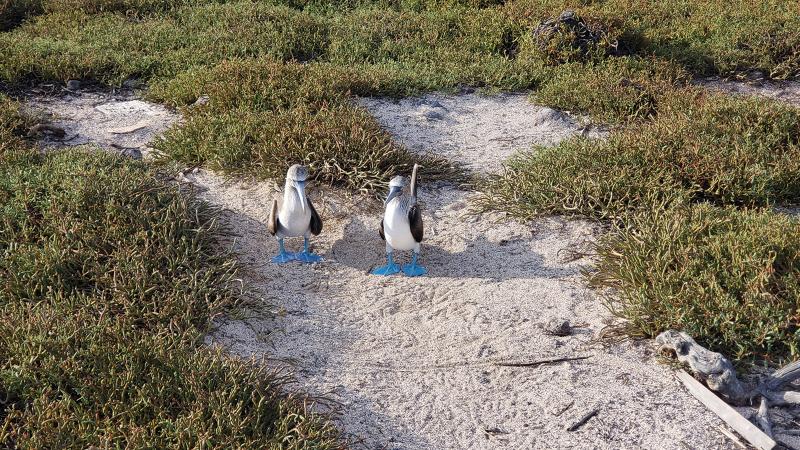
Good to know: Hurtigruten has a very big European clientele—specifically the German market. Metropolitan Touring has a mostly American client base. (This is one such reason that the partnership works: Access to an entirely new demographic of travelers.) On our sailing, it was nearly 50/50 between Americans and Germans (with maybe a few more Americans). So far this year, the breakdown has varied by sailing. There were some instances where folks were split up for lectures in either English or German, and travelers from the U.S. and Germany were usually grouped together in the pangas and tour groups for ease of communication. While there were kids on board, families were in the minority. Most guests were middle aged or older.
Guests are also broken into small groups (usually no more than 12) at the beginning of the sailing; you will remain with this group for all of your morning shore excursions throughout the voyage. You will also be assigned a tour guide from the Galápagos National Park Service who will lead your group throughout the week. For the optional shore excursions in the afternoon (say, the kayakers), guests will board a panga with the other guests who selected the same activity. Each panga will still have a guide from the National Park Service and all guests will need to return to the same panga they boarded afterwards.
Note: The Galápagos National Park Service guides are (rightfully) very strict about regulations in both the Galápagos and Ecuador. During our visit, masks were mandated in all public spaces, including outdoors. This meant, even in our group of eight, while we toured these otherwise deserted islands, masks had to be worn the entire time. (If you needed to take a breather, guides asked if you could step away from the group to remove the mask as needed, but to not keep it off too long and return to the group.) The team onboard, led by Hurtigruten Expeditions and Metropolitan Touring, also enforced the wearing of masks with the exception of when you were eating or drinking. So, if you feel this might be prohibitive to your health or experience of the destination, keep an eye on federal guidelines.
What to Pack
When it comes to what to wear, you want a combination of coverage and something that’s lightweight. We saw many folks wearing shorts and tee shirts but if you go this route, be sure to bring strong sunscreen and apply before and during your excursions. Long- and short-sleeved shirts with UV filters, like fishing shirts, are a good option. Fashion aside, nearly all tour guides wore zip-off pants, which are great in case you get too hot (or even too chilly in the evenings). Hats, in particular wide-brimmed sun hats that can protect your neck, are also very handy, as are sunglasses. You’ll need a range of shoes, as well: These can include something sturdy for your hikes, casual shoes or sneakers for onboard the ship, and either sandals or water shoes for wet landings. Be sure to bring a swimsuit as well—even if you don’t play on partaking in any of the water activities, there are times where you can relax on the beach and enjoy the water; or you can make use of the two hot tubs available on board. Tip: There is a very small gym onboard, consisting of a few treadmills, ellipticals and stationary bikes, along with some light dumbbells and yoga mats. We did see folks making use of the space, so feel free to bring some athletic clothing if you think you would, too. (The hiking, snorkeling and paddle boarding were plenty for us, though.)
Good to know: While there isn’t laundry service available, the Santa Cruz II does have its own washers and dryers that guests are allowed to use.
If you’re a photographer, we probably don’t have to remind you to bring your camera—but bring more memory cards than you might think. Tip: Underwater cameras like GoPros or even waterproof disposable cameras are great for snorkeling or any other boating excursions. A backpack and even a dry bag are good ideas to carry a water bottle, sunscreen, insect repellent and camera equipment during excursions.
Hurtigruten’s guests stay at the five-star JW Marriott Hotel Quito for their two nights on land before heading to the Galápagos to embark on their voyage. The hotel is about 45 minutes from Mariscal Sucre Quito International Airport, the largest airport in Ecuador. The day the group boards the Santa Cruz II, they will fly out of Mariscal Sucre to Aeropuerto Internacional José Joaquín De Olmedo in Guayaquil, a port city southeast of Quito. The flight is less than an hour. Tip: If you can, sit on the right side of the plane; should the weather be clear, you will have impressive views of the Andes during your flight. When you land at Guayaquil, all travelers continuing on to the Galápagos stay on the aircraft, while those just making the trip to Guayaquil get off. Once new travelers are boarded and seated, it’s off to Balta’s Seymour Ecological Galapagos Airport (which was formerly operated by the United States Air Force in World War II); the second leg of the flight is just about two hours.
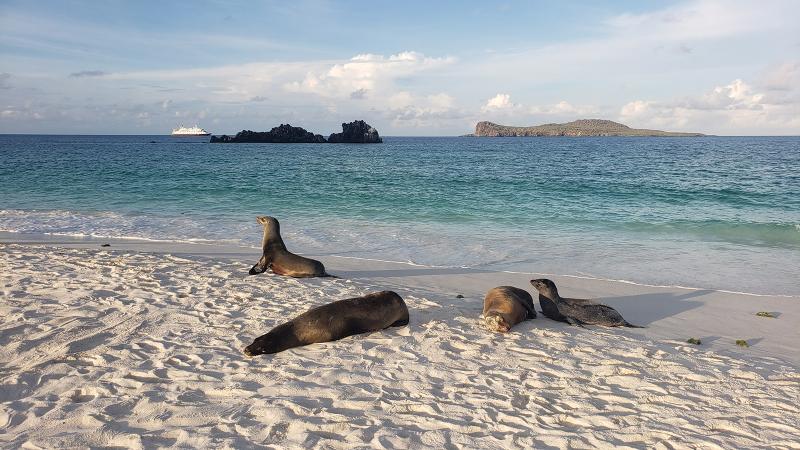
Cruise Extensions
Thanks to Hurtigruten Expeditions’ partnership with Metropolitan Touring, it is also offering a variety of pre- and post-cruise extensions. Options include stays at Finch Bay on Santa Cruz in the Galápagos, Hotel Casa Gangotena in Quito’s historic center, and Mashpi Lodge, an eco-reserve in the Chocó Rainforest, about three hours from Quito. During our trip to Ecuador, we spent a night each at the latter two, while we had the chance to enjoy lunch at the first. We would have stayed another night or two at any of them had we the time. As for which you should select for your pre- or post-stay? Since they offer you such different experiences—a beach hotel, a city center stay and a mountain lodge—it’s really a matter of preference.
That said, Mashpi Lodge was an incredible experience. First and foremost, the property functions as an eco-preserve with a science center adjacent to the lodge that conducts research on the fauna and flora of the region. In fact, the reserve existed for 10 years before the lodge was even built—and it was mostly created to generate income for the research, pay park rangers (most of whom live in the surrounding communities) and protect the land.
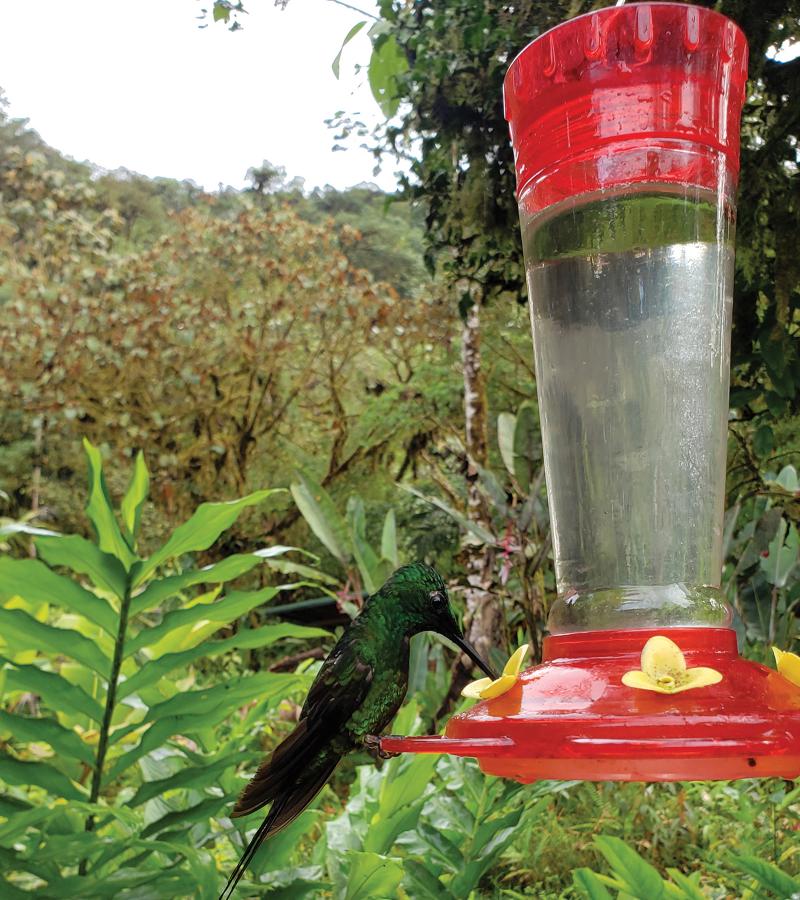
Don’t hear what we’re not saying, though: Mashpi Lodge is every bit a luxury experience. There are 24 rooms (three suites) that are all located on the same side of the lodge (meaning roughly similar views). There’s one restaurant and a bar that’s open for all three meals and a spa with two treatment rooms. There’s also a yoga deck and a lounge. In your room, once you pull yourself away from your floor-to-ceiling windows that act as an open wall to the rainforest beyond, you’ll find a bathrobe and slippers, a drawstring backpack, refillable water bottle and insect repellent to use throughout your stay. Like the Santa Cruz II, there are no TVs in the room (but, again, we didn’t spend much time there.) We suggest at night opening your window to enjoy the sounds of the birds, frogs and bugs (don’t worry, there’s a screen).
Days at Mashpi can start early. One morning, we woke up before 6 a.m. to take a brief van ride to an area of the preserve where many birds can be spotted (“the early bird,” as they say). Guides will provide you with binoculars to spot colorful birds in trees; the coolest we saw was a toucan. Following a bit of early-morning birdwatching, we made our way to the Hummingbird Garden where feeders are set up to attract hummingbirds (and they will come by the dozen). Here, breakfast was set up by your guides; it included coffee and hot chocolate, pastries, yogurt and granola, and fruits, meats and cheeses. Beyond hummingbirds, you might get the chance to spot some native wildlife.
Following breakfast, it’s off for a hike. The lodge also provides guests with tall rainboots (a must) and a walking stick if you’d like. Like the Galápagos, we would wear shorts or lightweight pants that you don’t mind getting a little wet. If you choose shorts, be sure to pack long socks to avoid chafing while wearing the rainboots; also be sure to use plenty insect repellent on any exposed skin. It’s also good to dress in layers; a rain jacket and shirt were fine for us during our stay. Should you not have a rain jacket, your guide can pack a poncho for you and will hold onto it until you need it.
Hikes ventured through trails in the forest and (even cooler) directly in the middle of shallow rivers to get an entirely different perspective on the forest. You’ll come across several waterfalls, so be sure to pack a bathing suit (or wear one under your clothes), so you can enjoy a little refresher. (Guides will pack lightweight towels that you can use to dry off.) One such waterfall had fairly deep pool that you can swim in, which was very cool. For an aerial view, there’s a roughly 100-foot-tall observation tower but the real highlights were the Sky Bike and Dragonfly. The former is a two-person bike suspended from a cable about 180 feet in the air. It moves as you pedal, so you can control when to stop to take in the views or when to move along. The latter is a four-person gondola, akin to a ski lift; it also takes you about 200 feet in the air, but while the bike is only a few-hundred yards long, the Dragonfly goes for nearly a mile.
Mashpi even provides night hikes, as many species of animal on property are nocturnal. Once you don your rainboot and headlamp (also provided by Mashpi), it’s off into the forest. It’s impressive when your guides spot birds and other small animals on your daytime hikes; it seems nearly superhuman when they spot tiny frogs blending into leaves during night hikes.
And speaking off tiny frogs on leaves, Mashpi Lodge just prior to our visit announced the discovery of a new species of glass frog, just a few inches long. The name comes from its nearly see-through skin (meaning you can see its organs and bones). We were able to witness one up close at the Science Center and then on our night hike, we released it back into the wild. It was such a cool experience. In all, 70 new species have been discovered on the 6,000-acre property since it opened.
Back in Quito, Casa Gangotena is a restored Renaissance-inspired mansion, with ornate neo-classical furnishings and spacious rooms. A member of Relais & Châteaux, the hotel has 31 guestrooms outfitted with modern technologies (including a television), along with an all-day restaurant serving locally inspired cuisine, a bar and a third-floor terrace with views of the city. Casa Gangotena is within walking distance of sights and scenes throughout Old Town Quito, which was declared as UNESCO’s first-ever World Heritage Site city in 1978.
Tip: Be sure to request a Plaza View Room, which offer views of the Historic Center, including the church and convent of San Francisco and its expansive cobbled square. For those who need more space, the Suites connect two Luxury Room.
If you want to continue your Galápagos experience but at a slower pace, Finch Bay is a 27-room property in Puerto Ayora on Santa Cruz Island. In late 2015 the hotel underwent an extensive renovation led by Ecuadorian interior designer, Julio Vinueza, revealing a chic new look. Summer 2019 also saw the opening of a hotel spa and unique wellness concept for the archipelago. The hotel also renovated its pool during the COVID pandemic.
Like on the Santa Cruz II, dining at Mashpi Lodge, Casa Gangotena and Finch Bay were tremendous.
About the Partnership
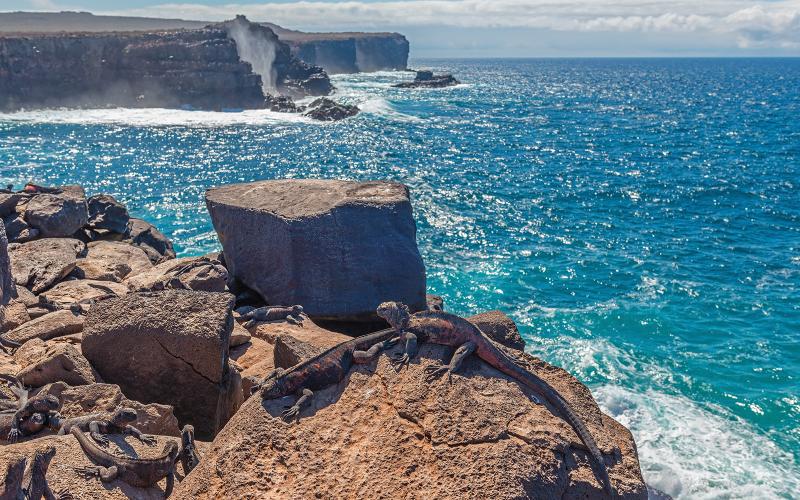
Last June, Hurtigruten Group and Metropolitan Touring announced a partnership that would enable the cruise line to enter the Galápagos territory. This year, just prior to our sailing in March, Hurtigruten announced it had acquired a 24.9 percent minority stake in Metropolitan Touring. As part of the deal, the Santa Cruz II underwent an extensive renovation and was painted in Hurtigruten’s colors.
By partnering with the South American tour and cruise operator, Hurtigruten Expeditions was able to enter the Galápagos market (where Metropolitan Touring operates two additional vessels not linked with Hurtigruten), as only a certain number of vessels are permitted to operate in the waters. It also provides the cruise line with a broader range of American clientele, which it has been wanting to tap into. For Metropolitan Touring, whose guests mostly come from the States, it is now able to access Hurtigruten’s existing European clientele—particularly the German market.
Founded in 1953, Metropolitan Touring pioneered expedition cruising in Ecuador’s Galápagos Islands in the 1970s. Metropolitan Touring has a partner hotel in the Galápagos, as well, Finch Bay on the Island of Santa Cruz. On the Ecuadorian mainland, the boutique Casa Gangotena in Quito’s historic center, and Mashpi Lodge, an eco-lodge northwest of Quito, also form part of its partner portfolio.
Related Articles
Silversea Cruises’ Silver Origin Christened in Galápagos
Seabourn Pursuit Reaches Another Milestone